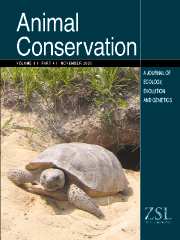Article contents
Protected areas and the conservation of grouse, partridges and pheasants in east Asia
Published online by Cambridge University Press: 01 May 1999
Abstract
Grouse, partridges and pheasants belong to the highly threatened avian order Galliformes. We collected together existing data on the distribution of these species in east Asia (China and Pakistan south and east to the Lesser Sundas in Indonesia and Palawan in the Philippines) from published and unpublished sources. From this we extracted 1068 records of 101 east Asian endemics (plus three other species that have been found in east Asian protected areas) in 369 protected areas. One species was found in 108 protected areas and a further two in 39 and 38 protected areas: six species were not known from any. Of the threatened endemics, 84% were recorded in 10 or fewer protected areas compared with 50% of endemic species that are non-threatened. A near-minimum network designed to include each species in three protected areas wherever possible comprised 49 irreplaceable sites and 33 others. Comparison with other studies should indicate which of these protected areas are also important for other groups of organisms, such as plants and swallowtail butterflies. There is a need for improvement in knowledge of occurrence in protected areas. This should be provided from further collation of existing information and from undertaking targeted surveys. There is also a need to consider which protected areas are suitable for inclusion in a network and how many such areas are required to ensure that each species is adequately represented.
- Type
- Research Article
- Information
- Copyright
- © 1999 The Zoological Society of London
- 8
- Cited by


